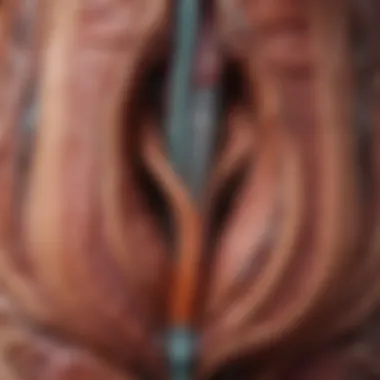Understanding Interstitial Cystitis and Autoimmunity


Article Overview
Purpose of the Article
This article sets out to illuminate the intricate world of interstitial cystitis (IC), specifically addressing its classification as an autoimmune condition. IC impacts countless individuals, often leading to a life filled with discomfort, confusion, and a search for answers. By dissecting the nuances of IC—from its symptoms to diagnostic hurdles—we aim to arm healthcare professionals and patients alike with knowledge that can transform management. Understanding the autoimmune links within this context can facilitate better treatment strategies and patient outcomes.
Relevance to Multiple Disciplines
The significance of interstitial cystitis stretches across various fields, including urology, immunology, and even psychology. As researchers strive to grasp the autoimmune framework of IC, the interplay of biological processes becomes evident. Clinicians benefit from this knowledge as it allows them to tailor treatment plans that address not just the urinary aspects of the disease but the overarching immune dysfunction. Furthermore, educators can leverage this understanding in their teaching, illustrating the comprehensive nature of autoimmune disorders and their complexities.
Research Background
Historical Context
The recognition of interstitial cystitis as a distinct entity dates back over a century. Initially dismissed as a psychological issue or simply "bladder pain syndrome," the medical community gradually began to acknowledge its physiological roots. As research progressed, significant correlations between IC and autoimmune diseases emerged, leading to a paradigm shift in understanding the condition.
Key Concepts and Definitions
Understanding interstitial cystitis necessitates clarity on some key concepts:
- Autoimmunity: The body's immune system mistakenly attacks its tissues. In the context of IC, this can lead to inflammation of the bladder with no identifiable cause.
- Pathophysiology: This term refers to how the disease process develops. For IC, this involves an alteration in bladder function and increased sensitivity to bladder distention.
- Comorbidities: Many individuals with IC also suffer from other autoimmune disorders, such as lupus or rheumatoid arthritis.
These concepts help normalize clinical discussions and empower patients to comprehend their condition. They are pivotal in framing the current understanding of interstitial cystitis as not just a symptom but a significant health challenge requiring holistic approaches.
"Understanding the autoimmune aspects of interstitial cystitis can illuminate pathways to innovative treatments and improved patient care."
"Understanding the autoimmune aspects of interstitial cystitis can illuminate pathways to innovative treatments and improved patient care."
The quest for knowledge in this area remains ongoing, underscoring the importance of further research in both basic science and clinical applications.
Prelude to Interstitial Cystitis
Understanding interstitial cystitis (IC) is crucial for both healthcare professionals and those affected by this debilitating condition. Through a deeper look into its complexities, we can better grasp how it impacts daily life, mental health, and overall well-being. Identifying its connections to autoimmune issues not only sheds light on its pathophysiology but also emphasizes the need for a holistic approach to treatment and management. This section will delve into IC’s definition, its historical context, and how current perspectives are evolving.
Definition of Interstitial Cystitis
Interstitial cystitis is a chronic disorder characterized by pelvic pain, pressure, and discomfort in the bladder and surrounding areas. The symptoms can often mimic those of a urinary tract infection, yet results from tests usually show no signs of infection. This makes IC particularly challenging to diagnose and manage. It's like having a gray cloud hovering over a sunny day—patients feel constant discomfort yet cannot pinpoint the reason behind it. IC extends beyond mere physical symptoms, impacting emotional and social aspects of a person's life.
Historical Context
The recognition of IC has evolved over the years. Initially, in the early 20th century, many considered it a psychological ailment. It wasn’t until the 1980s that the medical community started to understand IC as a clinical entity of its own. This shift marked a turning point in how patients were treated, moving from frequently being dismissed to more rigorous forms of diagnosis and treatment. The advent of new diagnostic measures allowed clinicians to better identify the condition, recognizing its multifaceted nature.
Current Perspectives on
Today, the understanding of IC continues to expand. It is increasingly viewed through the lens of autoimmune disorders, as many patients with IC also exhibit symptoms of other autoimmune diseases. Perspectives have shifted from viewing IC solely as a urological issue to understanding its potential connections with systemic ailments, which opens new avenues for treatment. Additionally, research is ongoing, and new potential therapies are being explored, providing hope for those affected.
"Interstitial cystitis is not just a bladder problem; it's a complex interplay of multiple factors, including possible autoimmune responses."
"Interstitial cystitis is not just a bladder problem; it's a complex interplay of multiple factors, including possible autoimmune responses."
This evolving narrative showcases the importance of recognizing the interplay between interstitial cystitis and autoimmune health. As we delve further into the connections, symptoms, and treatment opportunities, it is clear that a comprehensive approach is fundamental in addressing this intricate condition.
Understanding Autoimmune Diseases
Understanding autoimmune diseases is crucial, especially when investigating their connections to conditions like interstitial cystitis (IC). These diseases occur when the body’s immune system mistakenly attacks its tissues, interpreting them as foreign invaders. As we delve deeper into IC, we will find that the autoimmune aspects can provide insights into its etiology and treatment options. Exploring the mechanisms underlying autoimmunity will reveal potential pathways through which IC manifests, helping both clinicians and patients navigate the complexities of this disorder.
What Constitutes an Autoimmune Disease?
An autoimmune disease is characterized by an immune response directed against the body’s own tissues. This happens when the immune system, which normally protects against pathogens, mistakenly targets self-antigens. The result can be widespread inflammation and damage to affected organs or systems. Some essential points to understand these diseases include:
- Tolerance Breakdown: The body typically maintains tolerance to its antigens. A failure here can lead to autoimmunity.
- Genetic Factors: Certain genetic predispositions can increase the likelihood of developing autoimmune diseases. For instance, specific HLA (human leukocyte antigen) gene variations have been associated with many autoimmune disorders.
- Environmental Triggers: External factors such as infections or chemical exposures can trigger autoimmune responses in genetically susceptible individuals.
Mechanisms of Autoimmunity
The mechanisms of autoimmunity can be multifaceted and often involve:


- Molecular Mimicry: Some pathogens have antigens resembling host tissue, leading to cross-reactivity. For example, certain bacteria that might cause an infection can also stimulate an immune response that damages the tissues of the bladder.
- Epitope Spreading: Once the immune system targets a specific antigen, it may inadvertently recognize additional self-antigens, amplifying the autoimmune response.
- Loss of Regulatory T Cells: These cells help to keep the immune response in check. A reduction in their activity may lead to uncontrolled immune responses against self.
Recognizing these mechanisms sheds light on why some individuals develop IC in connection with other autoimmune conditions, highlighting the need for a nuanced approach to treatment.
Common Autoimmune Disorders
Autoimmune diseases come in various forms, affecting different systems in the body. Some notable examples include:
- Rheumatoid Arthritis (RA): Affecting joints, RA can lead to significant pain and disability.
- Systemic Lupus Erythematosus (SLE): This complex disease can affect multiple systems; its symptoms can range widely, from fatigue to organ inflammation.
- Multiple Sclerosis (MS): In this disease, the immune system attacks the protective sheath covering nerves, leading to various neurological symptoms.
- Type 1 Diabetes: This occurs when the immune system destroys insulin-producing cells in the pancreas.
These disorders often share symptoms and treatment strategies, which may be beneficial when we look at managing IC, especially considering that an individual with one autoimmune disease may be at higher risk for others.
"Understanding these diverse autoimmune conditions is critical because it can reveal patterns and shared vulnerabilities that provide deeper insights into managing each individual condition effectively."
"Understanding these diverse autoimmune conditions is critical because it can reveal patterns and shared vulnerabilities that provide deeper insights into managing each individual condition effectively."
By grasping the interconnectedness of autoimmune diseases and the specifics of each, healthcare amateurs and experts alike can foster better strategies for diagnosis and management, particularly for conditions such as interstitial cystitis.
The Link Between Interstitial Cystitis and Autoimmunity
Understanding the connection between interstitial cystitis (IC) and autoimmune diseases is crucial for unraveling the complexities of this condition. Not only does it shine a light on the potential underlying mechanisms, but it also aids in effective management and treatment approaches. Recognizing IC as possibly sharing pathways with autoimmune disorders encourages both research and clinical perspectives to evolve, fostering a future of enhanced patient care. This section dives into the immunological framework of IC and explores how it may intersect with other well-known autoimmune conditions.
The Immunological Basis of
The immunological perspective of interstitial cystitis presents an intriguing landscape. Several studies suggest that IC could be driven by glimmers of autoimmune processes. Essentially, the immune system, tasked with protecting the body from alien invaders, may begin targeting the body’s tissues in a misguided manner. In the bladder, this could lead to inflammation and symptoms typical of IC.
Research indicates elevated levels of certain biomarkers in individuals with IC, hinting at an ongoing immune response. These biomarkers, such as cytokines and immune cell types, can speak volumes about the health of the bladder and surrounding tissues. Therefore, in essence, understanding the immune dysregulation involved in IC provides a solid basis to adjust treatment strategies.
Moreover, some patients report symptom exacerbation following infections or acute stress, which further supports the thought that an overactive immune response plays a role. It paints a picture where the immune system could be seen as on constant alert, causing havoc when it mistakenly identifies the bladder's normal cells as harmful.
Overlap with Other Autoimmune Disorders
The universe of autoimmune diseases is vast, with conditions like lupus, rheumatoid arthritis, and Sjögren's syndrome frequently noticed as co-occurring with interstitial cystitis. This overlap has prompted researchers to ask whether shared pathways exist or if there is a common genetic susceptability at play.
Key highlights include:
- Shared Symptoms: Patients suffering from both IC and other autoimmune diseases often report overlapping symptoms like chronic pain and fatigue, indicating a systemic issue rather than isolated conditions.
- Genetic and Environmental Triggers: While the genetic foundations of autoimmune disorders vary, similarities in environmental triggers (like infections or stress) can exacerbate both IC and other conditions, exhibiting why they often appear hand-in-hand.
- Treatment Considerations: Understanding this overlap can influence treatment decisions. For example, therapies aimed at modulating the immune system, seen beneficial for conditions like lupus, might also offer insights or adjunct options for managing IC symptoms effectively.
Symptoms and Diagnosis of Interstitial Cystitis
Understanding the symptoms and diagnosis of interstitial cystitis (IC) is crucial for both patients and healthcare providers. IC is often misunderstood and misdiagnosed, leading to unnecessary suffering and delayed treatment. Recognizing the core symptoms can provide significant insight into the condition, while a clear diagnostic process is essential for establishing an effective management plan.
Core Symptoms of
The primary symptoms of interstitial cystitis can often be intricate and overlapping with other urological conditions. Patients typically experience:
- Chronic pelvic pain: This may be felt in the bladder and even extend to the lower abdomen, lower back, and perineum.
- Frequent urination: Patients can find themselves needing to urinate upwards of 20 times a day, often with little warning. This urgency can significantly disrupt daily life.
- Pain during urination: Discomfort or pain may arise during or after urination, which complicates normal bladder function.
- Interstitial cystitis flares: Symptoms can intensify under stress or after certain dietary choices, leading to unpredictable cycles of relief and discomfort.
These symptoms can vary in intensity and duration, making them a challenge to pin down for diagnosis. Consequently, understanding these symptoms can aid in identifying IC early, avoiding the chaotic journey many patients face.
Diagnostic Criteria for
Diagnosing IC isn't straightforward due to its non-specific symptoms and often vague presentations. Healthcare providers typically conduct a comprehensive evaluation that includes:
- Medical history: A thorough review of the patient’s medical history and symptoms.
- Physical examination: This may include a pelvic exam to assess any sources of discomfort.
- Urinalysis: Important for ruling out infections and other potential urinary issues.
- Bladder diary: Patients may be asked to keep a record of their urination patterns and any associated pain.
- Cystoscopy: In some cases, a visual inspection of the bladder may be necessary to rule out other conditions, such as bladder cancer or infectious diseases.
These elements are paramount in aligning symptoms with the criteria for IC, which ultimately assists in a proper diagnosis.
Challenges in Diagnosis
Despite the available diagnostic tools, identifying IC poses considerable challenges. Numerous hurdles can cloud the path to an accurate diagnosis:
- Symptom overlap: The symptoms of IC are often similar to those of urinary tract infections (UTIs) and other conditions. This overlap can lead to misdiagnosis.
- Lack of awareness: Both patients and some healthcare providers may not be fully aware of IC, resulting in a reliance on more common diagnoses.
- Varying severity of symptoms: Because symptoms fluctuate, healthcare providers might see patients during periods of remission, complicating the diagnosis.
“The diagnostic journey for interstitial cystitis can be as vexing as the condition itself, leading many down a path of confusion and frustration.”
“The diagnostic journey for interstitial cystitis can be as vexing as the condition itself, leading many down a path of confusion and frustration.”


Understanding these challenges is integral, as it can encourage a more measured approach to the diagnosis and foster better communication between patients and their healthcare teams. The stakes are high; effective management hinges on an accurate diagnosis.
Impact of Interstitial Cystitis on Daily Life
Interstitial cystitis, often referred to as IC, has a profound impact on the daily lives of those who suffer from it. Recognizing how this condition affects not just the physical, but also the mental, social, and economic aspects of life is essential for understanding its true burden. This section aims to shed light on these elements, emphasizing the need for comprehensive care strategies that encompass all facets of a patient’s life.
Psychological and Emotional Effects
Living with interstitial cystitis can be like carrying a heavy weight that never quite shifts. Individuals often experience a range of psychological challenges stemming from the condition. The frequent and urgent need to urinate, along with chronic pelvic pain, can lead to heightened levels of anxiety and depression.
Many feel isolated due to the nature of their symptoms, which can lead to avoidance of social situations and even relationships. It’s not unusual for someone with IC to feel misunderstood by friends and family, which only compounds feelings of loneliness.
“It’s like trying to explain a storm that’s brewing in your body, but others just see a sunny day.”
“It’s like trying to explain a storm that’s brewing in your body, but others just see a sunny day.”
Furthermore, coping mechanisms are crucial for emotional resilience. Some patients may turn to support groups or online communities—like those found on reddit.com—where shared experiences can offer solace and understanding. Therapeutic interventions, such as counseling or cognitive-behavioral therapy, can also be beneficial in allowing individuals to express their feelings, develop coping strategies, and manage their emotional responses to the chronic nature of IC.
Social and Economic Implications
The toll of interstitial cystitis extends beyond just the individual; it bleeds into social and economic realms as well. Patients often face challenges in maintaining their usual routines, which can impact their jobs and social engagements. Missing work frequently due to symptoms not only affects productivity but can also place employment at risk. This instability can lead to significant financial hardships, especially for those who lack adequate health insurance coverage.
- Workplace Challenges: Frequent restroom breaks and the unpredictability of symptoms may hinder job performance.
- Social Withdrawal: Individuals might shy away from gatherings, fearing that their bladder issues may create uncomfortable situations or that they won’t be able to find a bathroom in time.
- Financial Strain: The costs associated with medical visits, treatments, and medications can accumulate rapidly, leading to added stress. Many feel like they’re in a constant battle against their own body while trying to manage life’s other responsibilities.
In summary, the impact of interstitial cystitis on daily life can be all-encompassing, affecting everything from mental well-being to social interactions and financial stability. Addressing these issues through patient-centered care, support systems, and awareness can pave the way for a more manageable existence for those living with this condition.
Treatment Approaches for Interstitial Cystitis
Addressing interstitial cystitis (IC) demands a multi-faceted strategy that intertwines medical interventions with lifestyle considerations. A thorough understanding of treatment approaches is pivotal for patients and healthcare practitioners alike, as it shapes the course of managing a condition that significantly disrupts daily life.
Medical Management Options
The realm of medical management for interstitial cystitis is diverse and tailored to individual needs. Various treatments, from prescription medications to more invasive options, play important roles. Oral medications, such as pentosan polysulfate sodium, are often the first line of defense. They aim to restore the protective lining of the bladder, potentially alleviating some discomfort associated with IC.
In contrast, bladder instillations target localized symptoms by delivering medication directly into the bladder. This method allows for higher concentrations of medication to act directly on the affected area.
Furthermore, antidepressive medications, like amitriptyline, can help manage chronic pain and improve bladder capacity, offering relief to many patients.
"The choice of medication often hinges on a patient’s specific symptom profile and their overall health, requiring thoughtful discussion between the patient and their healthcare provider."
"The choice of medication often hinges on a patient’s specific symptom profile and their overall health, requiring thoughtful discussion between the patient and their healthcare provider."
Lifestyle Modifications
Lifestyle changes can have a significant impact on managing IC symptoms. These modifications often revolve around diet, hydration, and stress management. Patients frequently notice that certain foods or beverages can exacerbate their symptoms. Common triggers include caffeine, alcohol, spicy foods, and artificial sweeteners. Keeping a food diary can help pinpoint personal triggers.
Additionally, staying adequately hydrated while avoiding irritating substances can promote bladder health. The balance between maintaining hydration and not overwhelming the bladder can be tricky but essential.
Incorporating relaxation techniques, such as yoga or meditation, may also offer benefits. Reducing stress not only contributes to overall well-being but can also minimize flares of IC symptoms.
Physical Therapy and Alternative Treatments
Physical therapy specifically designed for pelvic floor dysfunction is gaining traction in the treatment of interstitial cystitis. This approach involves exercises to strengthen pelvic muscles, which can alleviate pain and improve bladder control.
In addition to physical therapy, alternative treatments such as acupuncture or chiropractic care may provide relief for some individuals. While research on these modalities may still be evolving, many patients report subjective improvements in their symptoms.
Combining traditional management methods with these alternative options can create a well-rounded approach to treatment, addressing both physical and emotional aspects of living with IC. Understanding that management is not one-size-fits-all presents an opportunity for patients to tailor their treatment as they see fit.
Current Research on Interstitial Cystitis
The realm of current research on interstitial cystitis (IC) is pivotal for understanding this multifaceted condition. Fresh insights continue to emerge from laboratories and clinics alike, providing a platform to dissect the intricate connections between IC and autoimmune disorders. These studies not only illuminate underlying mechanisms but also guide strategies for diagnosis, treatment, and patient care.
One of the crucial aspects of this research is the evolving narrative surrounding the immunological profile of IC. For example, investigations into inflammatory markers have highlighted notable differences in the urine of IC patients, suggesting a distinct immune response. This kind of data is invaluable. Understanding the immunological basis can offer clues to more tailored therapeutic strategies, benefitting those who grapple with IC daily.
Another important area of focus is the identification of the overlapping symptoms between IC and other autoimmune disorders. Patients often find themselves caught in a web of varying diagnoses and treatments, which can lead to frustration and a lack of comprehensive care. By exploring these overlaps, researchers aim to create a more streamlined approach to diagnosis and management, ultimately enhancing the quality of life for individuals affected by IC.
"The key to managing IC lies in understanding its autoimmune connections, which can pave the way for personalized treatment regimens."


"The key to managing IC lies in understanding its autoimmune connections, which can pave the way for personalized treatment regimens."
Recent Findings in Research
Recent studies have identified several intriguing findings that contribute to our understanding of interstitial cystitis. Notably, significant correlations have surfaced between genetic predispositions and the onset of IC. By examining populations with a higher incidence of autoimmune diseases, researchers have found genetic markers that could indicate susceptibility to IC. This opens the door to considering genetic testing as a future diagnostic tool.
Moreover, the role of the microbiome has garnered attention in the context of IC. Initial findings suggest that the bacterial composition in the gut might influence the severity of symptoms. The balance of beneficial versus harmful bacteria could play a role in modifying inflammation, leading to potential avenues for dietary or probiotic interventions.
Another striking discovery revolves around the relationship between stress and the exacerbation of IC symptoms. Recent psychosomatic research is shedding light on how psychological factors mitigate or amplify the physiologic responses of the bladder. Recognizing this link may lead to integrative treatment approaches that include cognitive-behavioral therapy as part of the management plan.
Future Directions for Studies
As we look to the future, several critical areas for exploration in interstitial cystitis research emerge. First and foremost, a multidimensional approach integrating the fields of immunology, microbiology, and psychology is likely to yield the most promising insights. Continued collaboration among these disciplines will help construct a holistic understanding of IC.
Additionally, the exploration of targeted therapies holds significant promise. Investigations into specific immunomodulatory drugs could be game-changers for managing this complex condition. Clinical trials involving personalized medicine approaches are essential for determining which therapies work best for individual patients.
Furthermore, advancing technology, such as wearable health devices, could enhance our understanding of IC. Real-time data concerning symptoms and triggers could facilitate the collection of extensive patient-reported outcomes, leading to richer datasets for researchers.
In summary, the current landscape of research on interstitial cystitis reveals a vibrant tapestry of potential paths forward. By focusing on genetic, microbiological, and psychological elements, the scientific community can reshape the narrative of IC, allowing for more effective management strategies tailored to individual patients.
Patient-Centered Care in Managing
Managing interstitial cystitis (IC) with a patient-centered approach is crucial for improving quality of life and outcomes. This perspective values the individual experiences and needs of patients, recognizing that each person’s journey with IC is unique. Engaging with patients not merely as subjects of treatment but as proactive participants in their own care fosters a collaborative atmosphere where their voices can be heard.
A patient-centered approach directs focus toward understanding the multifaceted nature of IC. This encompasses not only physical symptoms but also emotional and psychological aspects. It recognizes the interconnection between body and mind, understanding that chronic pain can have a significant impact on mental health. As the saying goes, "What weighs heavily on the heart often influences the body’s health." Thus, addressing emotional wellbeing alongside physical treatment is vital.
Benefits of Patient-Centered Care:
- Empowerment and Engagement: Patients feel more in control of their health choices, leading to greater adherence to treatment plans.
- Tailored Treatment Plans: Healthcare providers can better customize interventions based on the specific needs and preferences of the patient.
- Enhanced Communication: Open dialogue between patient and provider can facilitate better understanding and trust, improving the therapeutic relationship.
- Improved Outcomes: Studies suggest that a patient-centered approach can lead to enhanced health outcomes and reduced symptom burden.
Ultimately, incorporating patient feedback into treatment strategies leads to a more holistic approach. It not only addresses the medical aspects but also the lifestyle and emotional components that are crucial in managing IC.
Importance of Patient Education
Patient education serves as a cornerstone of effective management in IC. Providing patients and their families with accurate information equips them to make informed decisions regarding their treatment options. When patients understand their condition—what IC entails, its probable triggers, and coping strategies—they are likelier to manage their symptoms proactively.
- Knowledge is Power: A well-informed patient can spot flare-ups early and take timely action.
- Reduction in Anxiety: Understanding the condition often alleviates fears and misinformation, fostering a sense of security.
- Informed Decision-Making: Patients can weigh the benefits and risks of various treatments, leading to better outcomes.
Patient education can be facilitated through workshops, informational handouts, and online resources, ensuring sustained access to knowledge. Sharing findings from trustworthy platforms like Wikipedia or Britannica can reinforce understanding, helping patients to navigate the challenging landscape of IC management without feeling overwhelmed.
Support Systems and Resources
Building a robust support system is crucial for individuals battling IC. The unique challenges posed by this condition can be daunting, and knowing there is a community or network of resources available can make a world of difference. Support networks can provide not just emotional backing, but practical advice and shared experiences which can be invaluable.
- Patient Support Groups: Connecting with others facing similar challenges can foster a sense of belonging and decrease feelings of isolation.
- Online Forums and Social Media: Platforms like Reddit allow patients to share insights and resources in real-time, providing both advice and camaraderie.
- Healthcare Professional Networks: Having access to a knowledgeable team can help patients feel secure in their treatment journey and ensure they receive comprehensive care.
Patients should be encouraged to utilize local and online resources, including non-profit organizations that focus on bladder health, wellness groups, and even virtual health seminars. In addition, professional guidance, whether from urologists or therapists, is key in navigating the condition effectively. These systems combine to create a safety net, emphasizing that individuals do not have to endure their struggles in isolation.
The essence of support is not just to provide help, but to foster resilience and hope in paths yet to be traveled.
The essence of support is not just to provide help, but to foster resilience and hope in paths yet to be traveled.
Closure: The Future of Research and Treatment
As we reflect on the journey through the multifaceted landscape of interstitial cystitis (IC), it becomes clear that the dialogue around it must continue. This conclusion serves not only as a summarization but as a call to action. The complexities of IC and its autoimmune connections demand ongoing exploration. Understanding this relationship can provide key insights into better diagnostics and improved treatment strategies, ultimately translating into enhanced patient outcomes.
Summary of Key Points
In recapping our discussion, several crucial aspects stand out:
- Interstitial Cystitis as an Autoimmune Condition: The idea that IC may share characteristics with other autoimmune disorders reshapes our understanding of this condition. Uncovering these links can bolster both diagnosis and management strategies.
- Individualized Treatment Approaches: We underscored the need for personalized care, where treatment plans are tailored to the unique profiles of patients, considering their specific symptoms and autoimmune profiles.
- Holistic Management: The exploration of lifestyle modifications, psychological impacts, and community support systems has highlighted the necessity of a comprehensive management approach, which transcends mere medical interventions.
- Emerging Research: We touched on the latest findings in the research realm that hint at promising new avenues for both treatment and understanding of IC.
"To witness progress in understanding interstitial cystitis, we require a synergy between research, clinical practice, and patient involvement."
"To witness progress in understanding interstitial cystitis, we require a synergy between research, clinical practice, and patient involvement."
The Need for Continued Research
Research into interstitial cystitis must not be a stagnant pool; it should be an ever-flowing river, continuously seeking new pathways. While we have made significant strides, many questions linger:
- Mechanisms of Autoimmunity: What precise mechanisms underpin the autoimmune traits observed in IC? Identifying these pathways could reveal innovative therapeutic targets.
- Longitudinal Studies: More extensive longitudinal studies are necessary to understand how IC progresses over time and its interactions with other autoimmune diseases.
- Patient-Centric Research: Encouraging patients to engage in research not only enriches our data pool but also empowers those affected to advocate for their health needs.
The integration of these research elements can illuminate the path forward. As we move into a future that embraces both technological advancements and patient-centered approaches, the inhabitants of this field will find opportunities not just for knowledge but for transformative care options.



